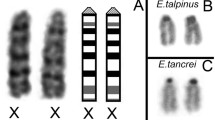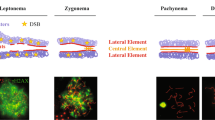Summary
The chromosome replication pattern of a man with 49,XXXXY was analyzed using 3H-thymidine and autoradiography as well as BrdU and acridine orange. The former technique showed a highly irregular replication pattern; the latter revealed one early replicating X chromosome, and the other three more or less asynchronously replicating. Two hypotheses seem to explain best the abnormal phenotype of males with an XXXXY sex chromosome constitution: (1) The number of the always active regions (tip of Xp) and of the possibly always active regions (the Q-dark regions on both sides of the centromere) is increased from one to four. (2) The replication pattern of the late-replicating X chromosomes is highly asynchronous, which might affect the phenotype. The possibility that more than one X chromosome might remain active in some cells, an even more abnormal and obviously deleterious situation, is still open.
Similar content being viewed by others
References
Alvesalo L, Tammisalo E (1981) Enamel thickness in 45,X females' permanent teeth. Am J Hum Genet 33:464–469
Alvesalo L, Tammisalo E, de la Chapelle A (1981) Mapping of the gene(s) influencing amelogenesis in man. J Dent Res 60A:403
Barlow P (1973) The influence of inactive chromosomes on human development. Humangenetik 17:105–136
Fragoso R, Hernandez A, Plascencia ML, Nazara Z, Martinez y Martinez R, Cantu JM (1982) 49,XXXXX syndrome. Ann Génét (Paris) 25:145–148
Lyon MF (1974) Mechanisms and evolutionary origins of variable X-chromosome activity in mammals. Proc R Soc Lond [Biol] 187: 243–268
Lyon MF (1983) The X chromosomes and their levels of activation. In: Sandberg AA (ed) Cytogenetics of the mammalian X chromosome, part A, Liss, New York, pp 187–204
Mikkelsen M (1976) Identification of active and inactive X chromosomes by BrdU incorporation and fluorochrome staining. In: Pearson PL, Lewis KR (eds) Chromosomes today, vol 5. Wiley, New York, pp 409–414
Otto PG, Therman E (1982) Spontaneous cell fusion and PCC formation in Bloom's syndrome. Chromosoma 85:143–148
Schempp W, Meer B (1983) Cytologic evidence for three human X-chromosomal segments escaping inactivation. Hum Genet 63: 171–174
Therman E (1983) Mechanisms through which abnormal X chromosome constitutions affect the phenotype. In: Sandberg, AA (ed) Cytogenetics of the mammalian X chromosome, part B. Liss, New York, pp 159–173
Therman E, Patau K (1974) Abnormal X chromosome in man: origin, behavior and effects. Humangentik 25:1–16
Therman E, Sarto GE (1983) Inactivation center on the human X chromosome. In: Sandberg AA (ed) Cytogenetics of the mammalian X chromosome, part A. Liss, New York, pp 315–325
Therman E, Sarto GE, Disteche, C, Denniston C (1976) A possible active segment on the inactive human X chromosome. Chromosoma 59:137–145
Therman E, Denniston C, Sarto GE, Ulber M (1980) X chromosome constitution and the human female phenotype. Hum Genet 54:133–143
Zakharov AF (1983) Pattern of DNA replication of the X chromosomes: normal and supernumerary. In: Sandberg AA (ed) Cytogenetics of the mammalian X chromosome, part A. Liss, New York, pp 357–374
Zaleski WA, Houston CS, Pozsonyi J (1966) The XXXXY chromosome anomaly: report of three new cases and review of 30 cases from the literature. J Can Med Assoc 94:1143–1154
Author information
Authors and Affiliations
Rights and permissions
About this article
Cite this article
Sarto, G.E., Otto, P.G., Kuhn, E.M. et al. What causes the abnormal phenotype in a 49,XXXXY male?. Hum Genet 76, 1–4 (1987). https://doi.org/10.1007/BF00283041
Received:
Issue Date:
DOI: https://doi.org/10.1007/BF00283041




